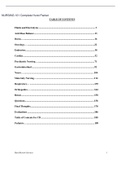NURSING 101 (Summary Summary Marilyn Hughes Age: 45 years Diagnosis: Lower Leg Fracture Complete Log.)
Chamberlain College Nursing
Page 2 out of 41 results
Sort by
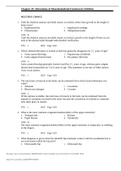
-
NURSING 101 Chapter 45: Alterations of Musculoskeletal Function in Children
- Exam (elaborations) • 8 pages • 2022
- Available in package deal
-
- $10.99
- + learn more
1. Until the skeleton matures and adult stature is reached, where does growth in the length of bone occur? a. Epiphyseal line c. Epiphyseal cartilage b. Physeal plate d. Metaphyseal plate ANS: B Until the skeleton matures and adult stature is reached, growth in the length of bone occurs only at the physeal plate through endochondral ossification. PTS: 1 REF: Page 1592 2. Which skeletal deformity is normal at birth but generally disappears by 21 / 2 years of age? a. Genu varum (bowle...
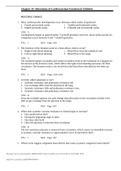
-
NURSING 101 Chapter 33: Alterations of Cardiovascular Function in Children
- Exam (elaborations) • 8 pages • 2022
- Available in package deal
-
- $8.99
- + learn more
. Most cardiovascular developments occur between which weeks of gestation? a. Fourth and seventh weeks c. Twelfth and fourteenth weeks b. Eighth and tenth weeks d. Fifteenth and seventeenth weeks ANS: A Cardiogenesis begins at approximately 3 weeksÕ gestation; however, most cardiovascular development occurs between 4 and 7 weeksÕ gestation. PTS: 1 REF: Page 1194 2. The function of the foramen ovale in a fetus allows what to occur? a. Right-to-left blood shunting c. Blood flow from the u...
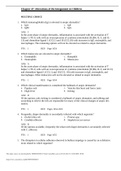
-
NURSING 101Chapter 47: Alterations of the Integument in Children
- Exam (elaborations) • 7 pages • 2022
- Available in package deal
-
- $7.99
- + learn more
Which immunoglobulin (Ig) is elevated in atopic dermatitis? a. IgA c. IgE b. IgM d. IgG ANS: C In the acute phase of atopic dermatitis, inflammation is associated with the activation of T helper 1 (Th-1) cells with an overexpression of cytokines (interleukin [IL]Ð4, IL-5, and IL13) and chemokine ligand 1 (CCL1) and 18 (CCL18) with increases in IgE, eosinophils, and macrophages. The remaining options will not be elevated as related to atopic dermatitis. PTS: 1 REF: Page 1654 2. Which leu...

-
NURSING 101Chapter 23: Structure and Function of the Reproductive Systems
- Exam (elaborations) • 9 pages • 2022
- Available in package deal
-
- $10.49
- + learn more
The initial reproductive structures of the male and female embryos appear the same until which week of gestation? a. Third c. Twentieth b. Eighth d. Thirtieth ANS: B Between 6 and 7 weeksÕ gestation, the male embryo differentiates under the influence of testes-determining factor (TDF). In the absence of testosterone, a loss of the wolffian system occurs and the two gonads develop into ovaries at 6 to 8 weeksÕ gestation. PTS: 1 REF: Page 769 2. The absence of which major hormone is a d...
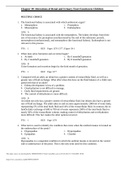
-
NURSING 101Chapter 39: Alterations of Renal and Urinary Tract Function in Children
- Exam (elaborations) • 8 pages • 2022
- Available in package deal
-
- $9.49
- + learn more
The functional kidney is associated with which embryonic organ? a. Metanephros c. Pronephros b. Mesonephros d. Endonephros ANS: A The functional kidney is associated with the metanephros. The kidney develops from three sets of structures: the pronephros (nonfunctional by the end of the embryonic period), mesonephros (nonfunctional), and metanephros (the functional kidney). Endonephros is not relevant to this process. PTS: 1 REF: Pages 1376-1377 | Figure 39-1 2. When does urine formation...
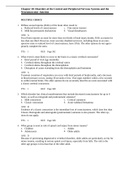
-
NURSING 101 Chapter 18: Disorders of the Central and Peripheral Nervous Systems and the Neuromuscular Junction
- Exam (elaborations) • 10 pages • 2022
- Available in package deal
-
- $11.99
- + learn more
. Diffuse axonal injuries (DAIs) of the brain often result in: a. Reduced levels of consciousness c. Fine motor tremors b. Mild but permanent dysfunction d. Visual disturbances ANS: A Focal brain injuries account for more than two-thirds of head injury deaths; DAIs accounts for less than one third. However, more severely disabled survivors, including those in an unresponsive state or reduced level of consciousness, have DAIs. The other options do not appropriately complete the stem. PTS: 1...

-
NURSING 101Chapter 20: Alterations of Neurologic Function in Children
- Exam (elaborations) • 6 pages • 2022
- Available in package deal
-
- $9.99
- + learn more
The neural groove closes dorsally during which week of gestational life? a. Second c. Eighth b. Fourth d. Twelfth ANS: B During the fourth gestational week, the neural groove deepens, its folds develop laterally, and it closes dorsally to form the neural tube, epithelial tissue that ultimately becomes the central nervous system (CNS). The second week is too early, and the other options represent times periods after the groove closes. PTS: 1 REF: Page 660 2. Which nutritional deficiency ...
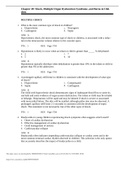
-
Nursing 101 Chapter 49 Shock, Multiple Organ Dysfunction Syndrome, and Burns in Children Test Bank
- Exam (elaborations) • 8 pages • 2022
- Available in package deal
-
- $8.49
- + learn more
. What is the most common type of shock in children? a. Hypovolemic c. Neurogenic b. Cardiogenic d. Septic ANS: A Hypovolemic shock, the most common type of shock in children, is associated with a reduction in the intravascular volume relative to the vascular space. PTS: 1 REF: Page 1703 2. Hypotension is likely to occur when an infant or child is greater than _____ % dehydrated. a. 2 c. 7 b. 5 d. 10 ANS: D Hypotension typically develops when dehydration is greater than 10% in the infa...
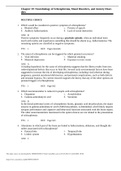
-
NURSING 101Chapter 19: Neurobiology of Schizophrenia, Mood Disorders, and Anxiety Disorders
- Exam (elaborations) • 7 pages • 2022
- Available in package deal
-
- $10.49
- + learn more
Which would be considered a positive symptom of schizophrenia? a. Blunted affect c. Poverty of speech b. Auditory hallucinations d. Lack of social interaction ANS: B Positive symptoms frequently occur during a psychotic episode, when an individual loses touch with reality and experiences something that should be absent (e.g., hallucinations). The remaining options are classified as negative symptoms. PTS: 1 REF: Pages 644-646 2. The onset of schizophrenia can be triggered by which prenat...
NURSING 101 Complete Hurst Packet

Study stress? For sellers on Stuvia, these are actually golden times. KA-CHING! Earn from your study resources too and start uploading now. Discover all about earning on Stuvia



